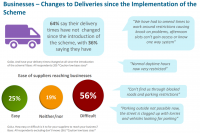I think you will find that all disabled children, at least, have parents who are also carers.You need to be physically able to drive, or have someone who can drive for you, do you not? It's not a solution that is available to all people with disabilities.
And many, if not the majority, are forced to drive because public transport is not suitable for children with behavioural and medical needs and barely suitable for those with mobility needs.
I wonder if the education transport buses will be allowed access to these now closed routes? Most of the children that travel on those already have very extended transport times to school because, you know, resources are finite.
















